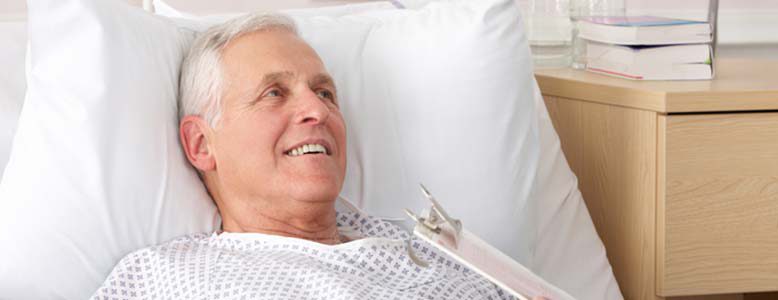After the surgery you will be transferred from recovery to the ward. When you first arrive back in the ward you will have a drip in your arm giving you fluids which is removed when you are drinking enough oral fluids.

You will have a catheter in your bladder connected to irrigation fluids. The drip and the catheter will be removed when the urine is clear with a minimal amount of blood in it.
Pain
You can expect to have mild pain at the operation site. Pain in the prostate is felt in the rectum, perineum or lower abdomen, and there are a number of ways to manage your pain. You will be ordered painkillers and if you have pain, it is important that you ask your nurse for some pain killers as you will recover faster if your pain level is controlled. The pain is usually not severe and should continue to decrease in intensity for 7-10 days after the operation.
Occasionally patients can have pain at the tip of their penis and the urgent desire to pass urine despite having a catheter in the bladder draining urine. This is called bladder spasms. It is due to the catheter irritating the bladder and causing the bladder to contract giving the sensation of the urgent need to pass urine. If this occurs, let the nursing staff know as there are several medications that can be used to treat these symptoms.
Intravenous fluid (Drip)
You will have a drip in your arm when you come back from surgery. This will be removed when you are able to eat and drink normally and when you are no longer feeling sick. If you feel nauseated please tell your nurse as she will be able to give you medication to make you feel better.
Bowels
You may experience some difficulty with moving your bowels in the early days after the surgery. It is important that you do not strain and if you are having trouble moving your bowels let the nursing staff know so they can give you some laxatives and stool softeners.
Catheter
Immediately after the operation the catheter is connected to irrigation fluids to wash blood and blood clots out of the bladder. As the urine clears the irrigation will be slowed and eventually stopped. The catheter will be removed when the urine is clear and this will usually occur on the second morning after the surgery. To remove the catheter the balloon that held it in the bladder is deflated. There is often a stinging sensation for a few seconds as the catheter passes out of the bladder into the urethra.
After it is removed most men pass urine normally, however occasionally some men have difficulty and require another catheter to be reinserted for a short time. Once the catheter is removed you will be observed for approximately 4 hours, and if you are passing urine normally you will be allowed to be discharged from hospital.
Urination
Once the catheter comes out you make have a burning sensation when you pass urine. This is quite normal and will usually settle within a few days. If the burning sensation lasts longer than 3 days or you have fevers, temperatures or feel unwell then you must contact Dr Swindle or your GP immediately.
Most patients will have an excellent flow immediately after the surgery but most men will have a period when they pass urine frequently and with some urgency. This is variable but can last up to 8-12 weeks and will eventually resolve. After a TURP a scab forms on the cut surface of the prostate. This scab usually falls off at around 7-10 days. When this occurs a small piece of tissue can be passed and some bleeding can occur. If this occurs don’t be alarmed but increase your fluid intake. It will usually settle within 24-48 hours. Contact Dr Swindle if you are passing large amounts of blood clots or if you are having trouble urinating.



